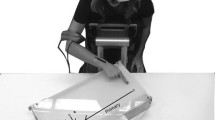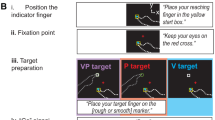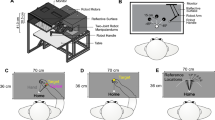Abstract
Studies investigating visuo-motor adaptation typically introduce sensory conflicts by manipulating visual information (prisms, cursor gains). The purpose of the present study was to determine whether similar adaptation would be observed when a conflict is created through distortion of the proprioceptive sense, rather than through visual distortion. We used a coordinated movement task that required participants to release thumb and index finger at a specific elbow angle during passive elbow extension. Participants could not see their arm, but were shown a cursor representing the forearm on a video screen. In the proprioceptive group, a sensory conflict was introduced by vibrating the biceps brachii muscle, introducing a discrepancy of approximately 7.5° between the proprioceptively perceived and visually perceived elbow angle. In the visual group, a conflict of similar magnitude was obtained by introducing a gain of 7.5° to the cursor with respect to forearm position. Adaptation was assessed by the presence of plastic changes in release elbow angles following a period of exposure to the sensory conflict (i.e., aftereffects). Both groups showed high accuracy during exposure despite the sensory conflicts. More importantly, the visual group presented large and persistent aftereffects, while the proprioceptive group presented none. We suggest that the proprioceptive group’s lack of adaptation was due to the artificial muscle spindle activity resulting from vibration, which prevented visual and proprioceptive signals to be merged into a common frame of reference.




Similar content being viewed by others
References
Baraduc P, Wolpert DM (2002) Adaptation to a visuomotor shift depends on the starting posture. J Neurophysiol 88:973–981
Calvin-Figuière S, Romaiguère P, Gilhodes JC, Roll JP (1999) Antagonist motor responses correlate with kinesthetic illusions induced by tendon vibration. Exp Brain Res 124:342–350
Carey DP, Allan K (1996) A motor signal and “visual” size perception. Exp Brain Res 110:482–486
Clower DM, Boussaoud D (2000) Selective use of perceptual recalibration versus visuomotor skill acquisition. J Neurophysiol 84:2703–2708
Collins DF, Refshauge KM, Todd G, Gandevia SC (2005) Cutaneous receptors contribute to kinesthesia at the index finger, elbow, and knee. J Neurophysiol 94:1699–1706
Cordo P, Carlton L, Bevan M, Carlton M, Kerr K (1994) Proprioceptive coordination of movement sequences: role of velocity and position information. J Neurophysiol 71:1848–1861
Cordo P, Vieira C, Verschueren SMP, Inglis JT, Gurfinkel V (2002) Position sensitivity of human muscle spindles: single afferent and population representations. J Neurophysiol 87:1186–1195
Cruse H, Dean J, Heuer H, Schmidt RA (1990) Utilization of sensory information for motor control. In: Neumann O, Prinz W (eds) Relationships between perception and action: Current approaches. Springer Berlin, pp 43–79
Edin BB (1992) Quantitative analysis of static strain sensitivity in human mechanoreceptors from hairy skin. J Neurophysiol 67:1105–1113
Edin BB (2001) Cutaneous afferents provide information about knee joint movements in humans. J Physiol 531:289–297
Fleury M, Bard C, Teasdale N, Michaud D, Lamarre Y (1999) How efficient are central mechanisms for the learning and retention of coincident timing actions? Neuropsychologia 37:723–730
Graydon FX, Friston KJ, Thomas CG, Brooks VB, Menon RS (2005) Learning-related fMRI activation associated with a rotational visuo-motor transformation. Cogn Brain Res 22:373–383
Guédon O, Gauthier G, Cole J, Vercher J-L, Blouin J (1998) Adaptation in visuomanual tracking depends on intact proprioception. J Mot Behav 30:234–248
Held R, Bossom J (1961) Neonatal deprivation and adult rearrangement: elementary techniques for analysing plastic sensori-motor coordinations. J Comp Physiol Psychol 54:33–37
Held R, Hein AV (1958) Adaptation of disarranged hand-eye coordination is contingent upon re-afferent stimulation. Percept Mot Skills 8:87–90
Houk JC, Rymer WZ, Crago PE (1981) Dependence of dynamic response of spindle receptors on muscle length and velocity. J Neurophysiol 46:143–166
Inglis JT, Frank JS (1990) The effect of agonist/antagonist muscle vibration on human position sense. Exp Brain Res 81:573–558
Kalaska JF, Caminiti R, Georgopoulos AP (1983) Cortical mechanisms related to the direction of two-dimensional arm movements: relation in parietal area 5 and comparison with motor cortex. Exp Brain Res 51:247–260
Krakauer JW, Ghilardi M-F, Ghez C (1999) Independent learning of internal models for kinematic and dynamic control of reaching. Nat 2:1026–1031
Lackner JR, Shenker B (1985) Proprioceptive influences on auditory and visual spatial localization. J Neurosci 5:579–583
Maravita A, Spence C, Driver J (2003) Multisensory integration and the body schema: close to hand and within reach. Curr Biol 13:R531–R539
Pick HJ, Hay JC (1965) A passive test of the Held reafference theory. Percept Mot Skills 20:1070–1072
Pisella L, Michel C, Gréa H, Tilikete C, Vighetto A, Rossetti Y (2004) Preserved prism adaptation in bilateral optic ataxia: strategic versus adaptive reaction to prisms. Exp Brain Res 156:399–408
Pipereit K, Bock O, Vercher JL (2006) The contribution of proprioceptive feedback to sensorimotor adaptation. Exp Brain Res. Published online March 10th
Redding GM, Wallace B (1996) Adaptive spatial alignment and strategic perceptual-motor control. J Exp Psychol Hum Percept Perform 22:379–394
Redding GM, Wallace B (1997) Adaptive spatial alignment. Lawrence Erlbaum Associates, Mahwah
Redding GM, Wallace B (2002) Strategic calibration and spatial alignment: a model from prism adaptation. J Mot Behav 34:126–138
Redding GM, Rossetti Y, Wallace B (2005) Applications of prism adaptation: a tutorial in theory and method. Neurosci Biobehav Rev 29:431–444
Roll JP, Vedel JP (1982) Kinaesthetic role of muscle afferents in man, studied by tendon vibration and microneurography. Exp Brain Res 47:177–190
Roll JP, Gilhodes JC, Tardy-Gervet MF (1980) Effets perceptifs et moteurs des vibrations musculaires chez l’homme normal: Mise en évidence d’une réponse des muscles antagonistes. Arch Ital Biol 118:51–71
Roll JL, Vedel JP, Ribot E (1989) Alteration of proprioceptive messages induced by tendon vibration in man: a microneurographic study. Exp Brain Res 76:213–222
Rushworth MF, Johansen-Berg H, Young SA (1998) Parietal cortex and spatial–postural transformation during arm movements. J Neurophysiol 79:478–482
Vallbo AB (1974) Afferent discharge from human muscle spindles in non-contracting muscles. Steady state impulse frequency as a function of joint angle. Acta Physiol Scand 90:303–318
Verschueren SMP, Cordo P, Swinnen S (1998) Representation of wrist joint kinematics by the ensemble of muscle spindles from synergistic muscles. J Neurophysiol 79:2265–2276
Welch RB (1978) Perceptual modification: adapting to altered sensory environments. Academic, New York
Author information
Authors and Affiliations
Corresponding author
Rights and permissions
About this article
Cite this article
Bernier, PM., Chua, R., Inglis, J.T. et al. Sensorimotor adaptation in response to proprioceptive bias. Exp Brain Res 177, 147–156 (2007). https://doi.org/10.1007/s00221-006-0658-5
Received:
Accepted:
Published:
Issue Date:
DOI: https://doi.org/10.1007/s00221-006-0658-5




